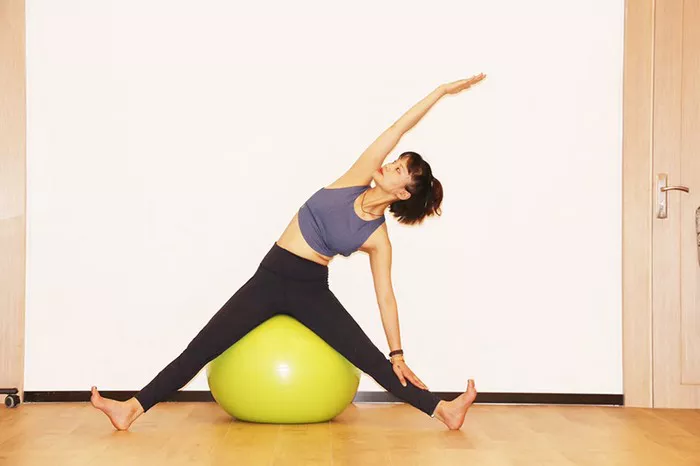Using a yoga ball as an office chair has become an increasingly popular choice for those looking to improve their posture, engage their core muscles, and add a bit of physical activity to their sedentary work life. This article will guide you through the benefits of using a yoga ball chair, how to choose the right ball, tips for proper setup and use, and safety considerations to keep in mind.
Benefits of Using a Yoga Ball as an Office Chair
Improved Posture
One of the primary benefits of using a yoga ball as an office chair is the potential improvement in posture. Traditional office chairs often lead to slouching and poor spinal alignment. A yoga ball, on the other hand, encourages you to sit up straight, as maintaining balance requires engaging your core muscles and aligning your spine correctly.
Enhanced Core Strength
Sitting on a yoga ball engages your core muscles continuously. This constant engagement can help strengthen the muscles of your abdomen, back, and pelvis. Over time, a stronger core can contribute to better overall stability and reduce the risk of lower back pain.
Increased Activity
A yoga ball chair promotes micro-movements, as you subtly shift your weight to maintain balance. These small movements can increase your overall activity level, which is beneficial for your health, especially if you have a predominantly sedentary job.
Reduced Back Pain
Many users report a reduction in back pain after switching to a yoga ball chair. This is likely due to the improved posture and strengthened core muscles. When your spine is aligned correctly and your core is supporting your back, there is less strain on your lower back.
Enhanced Focus and Productivity
The act of balancing on a yoga ball can keep you more alert and focused. The slight movements and engagement of your muscles can help prevent the sluggishness that often accompanies prolonged periods of sitting.
Choosing the Right Yoga Ball
Size
Choosing the right size yoga ball is crucial for comfort and effectiveness. The ball should allow you to sit with your feet flat on the floor, your knees bent at a 90-degree angle, and your thighs parallel to the ground. Generally, the following sizes are recommended based on your height:
- 55 cm ball for individuals 4’11” to 5’4″ tall
- 65 cm ball for individuals 5’5″ to 5’11” tall
- 75 cm ball for individuals 6’0″ to 6’7″ tall
Material and Durability
Ensure the yoga ball is made of high-quality, burst-resistant material. This ensures safety and longevity, especially when used as an office chair. Look for balls labeled as anti-burst or burst-resistant.
See Also: The Composition of Yoga Balls
Inflation Level
The ball should be inflated to the appropriate level. Over-inflation can make the ball too firm, reducing comfort and effectiveness. Under-inflation can make it too soft, compromising stability. Follow the manufacturer’s guidelines for inflation and adjust as needed for personal comfort.
Setting Up Your Yoga Ball Chair
Initial Setup
Inflate the Ball: Inflate the ball using a pump, following the manufacturer’s instructions. Make sure it is firm but still has some give when you sit on it.
Position the Ball: Place the ball at your desk where your regular chair would be. Ensure there is enough space around the ball to allow for movement and adjustments.
Ergonomic Considerations
Desk Height: Adjust your desk height if possible, so your forearms are parallel to the ground when typing. If your desk is not adjustable, consider using a keyboard tray or raising your monitor to eye level.
Monitor Position: Your computer monitor should be at eye level to avoid neck strain. Use a monitor stand or stack books under the monitor if necessary.
Foot Placement: Keep your feet flat on the floor with your knees at a 90-degree angle. Use a footrest if your feet do not comfortably reach the floor.
Using the Yoga Ball Chair Correctly
Starting Slowly
If you’re new to using a yoga ball chair, start slowly. Begin by sitting on the ball for short periods, such as 15-30 minutes, and gradually increase the time as your body adapts. This helps prevent muscle fatigue and ensures you build strength gradually.
Maintaining Good Posture
Spine Alignment: Sit up straight with your spine aligned. Avoid slouching or leaning forward.
Core Engagement: Engage your core muscles to maintain balance. This engagement helps support your spine and improve posture.
Weight Distribution: Keep your weight evenly distributed on the ball. Avoid shifting your weight to one side or leaning too far forward or backward.
Adding Movement
Micro-Movements: Subtle movements, such as shifting your weight or gently bouncing, can help keep your muscles active and prevent stiffness.
Stretch Breaks: Take regular breaks to stand, stretch, and walk around. This helps prevent muscle fatigue and promotes circulation.
Exercise Breaks: Incorporate short exercise breaks using the ball. Simple exercises like seated marches, pelvic tilts, and gentle bounces can enhance your activity level and strengthen your muscles.
Safety Considerations
Stability and Balance
Safety First: Always prioritize safety. Ensure the ball is properly inflated and free from damage.
Balance: Practice balancing on the ball before using it as a chair. This helps you become familiar with the feel and ensures you can maintain stability.
Avoid Distractions: Avoid using the ball as a chair during tasks that require intense focus or involve sharp objects, hot beverages, or delicate equipment.
Listening to Your Body
Comfort: If you experience discomfort or pain, stop using the ball and reassess your setup and posture.
Adjustments: Make necessary adjustments to your desk, monitor, and ball to ensure ergonomic comfort.
Consult a Professional: If you have pre-existing conditions or concerns, consult a healthcare professional before making the switch to a yoga ball chair.
Conclusion
Using a yoga ball as an office chair can offer numerous benefits, including improved posture, enhanced core strength, increased activity, reduced back pain, and enhanced focus. By choosing the right ball, setting up your workspace ergonomically, and using the ball correctly, you can create a healthier and more dynamic work environment. Remember to start slowly, listen to your body, and prioritize safety to make the most of this innovative seating option.
Related topics:
























